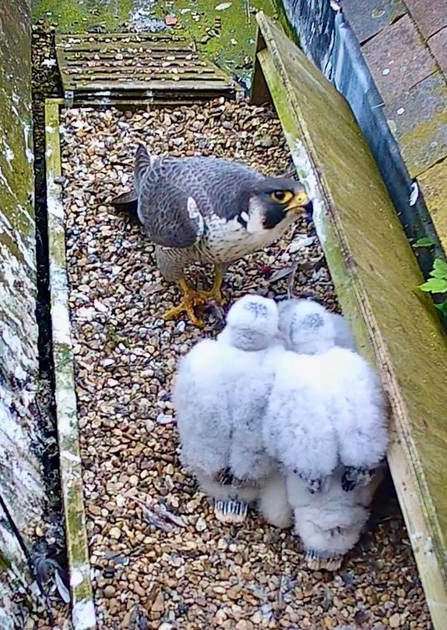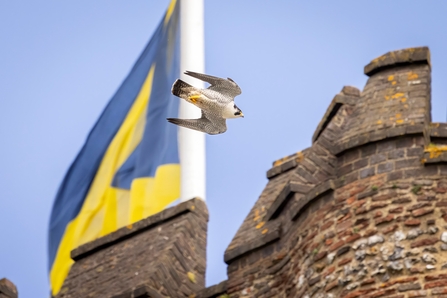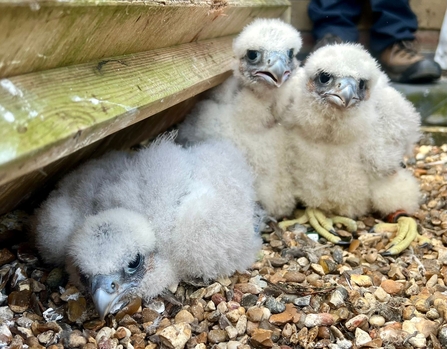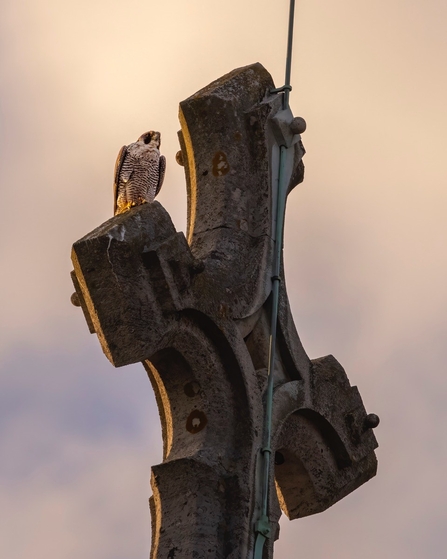
St Albans Peregrine © Patrick Wainwright
Peregrine Falcons at St Albans Cathedral
***7 May 2025 The Peregrine Falcons at St Albans Cathedral have laid a second clutch of eggs, following an incident in which their first eggs of the breeding season were destroyed last month.
Last year the webcam attracted over half a million views, and, following the incident on 7 April in which their three eggs were destroyed, understandably there has been a huge outpouring of public upset. Since then, the webcam has been turned off and a police investigation into the incident is ongoing. The birds have frequently been seen mating, and have gone on to defy the odds by breeding again this year - a first egg was laid on 4 May, a second on 7 May and there is still potential for more to follow.
The webcam, which has been sponsored by Opticron, will be switched back on, at 12.30pm on 7 May, enabling the public to follow the birds’ progress once again.***
Since 2022, a pair of Peregrine Falcons has made their home high up on St Albans Cathedral, and over the past three years, we’ve been lucky enough to watch as the Peregrines raise their chicks.
This incredible story began when a specially designed nesting tray was installed in March 2022, after the first sighting of the Peregrines. Thanks to the Wilder St Albans project – a partnership between Herts and Middlesex Wildlife Trust and St Albans City and District Council – and with help from local ornithologist Barry Trevis and bird photographer Kevin Garrett, the tray was placed in an area the birds had been favouring. The tray, filled with shingle, creates the perfect spot for the Peregrines to lay their eggs, simulating their natural cliff-side nests.
In 2023, a webcam was set up on the nest tray, giving us all the chance to watch the birds’ fascinating antics live. With over half a million views last year, it’s wonderful to see how many people are captivated by these remarkable birds. And with enhanced camera equipment this year, kindly sponsored by Opticron, there's an even better view to be had!

Peregrine chicks being fed on the nest tray at St Albans Cathedral after being ringed (c) Barry Trevis
You can watch the Peregrine Falcons in action by tuning into the live webcam at St Albans Cathedral. Click here for a birds’ eye view of the nest tray and explore the fascinating behaviour of these incredible birds. Please note, as with all wildlife, there may be times when the Peregrines are out of sight.

Peregrine Falcon at St Albans Cathedral (c) Patrick Wainwright
To dive deeper into the world of Peregrine Falcons, the Trust has created a helpful Peregrine Falcon Fact File, which you can download here. This fact file includes interesting information about the species, answers to your questions, and a history of the Peregrines at St Albans Cathedral. It’s a great way to learn more about these incredible birds and this remarkable local story!

Stay up to date with the latest news as we chart the Peregrine Falcons' breeding milestones at St Albans Cathedral, this year. From the highly anticipated switch-on of the webcam to exciting updates on the breeding pair and their potential offspring.

Peregrine Falcon on St Albans Cathedral (c) Patrick Wainwright
You can help support the Peregrines and local wildlife by purchasing a digital or postal Peregrine Sponsorship pack - a fantastic gift for nature lovers, which directly contributes to protecting the natural environment for these amazing birds and other local wildlife.

Peregrine on a cross at sunset (c) Patrick Wainwright
Throughout weekends over spring and summer, Herts and Middlesex Wildlife Trust and the St Albans Local RSPB Group host Peregrine Watch events in the Cathedral grounds. These events give the community a chance to learn more about these magnificent birds and get a close-up view through telescopes and binoculars, which will be provided. Keep an eye on our events page for more details as they are published.
